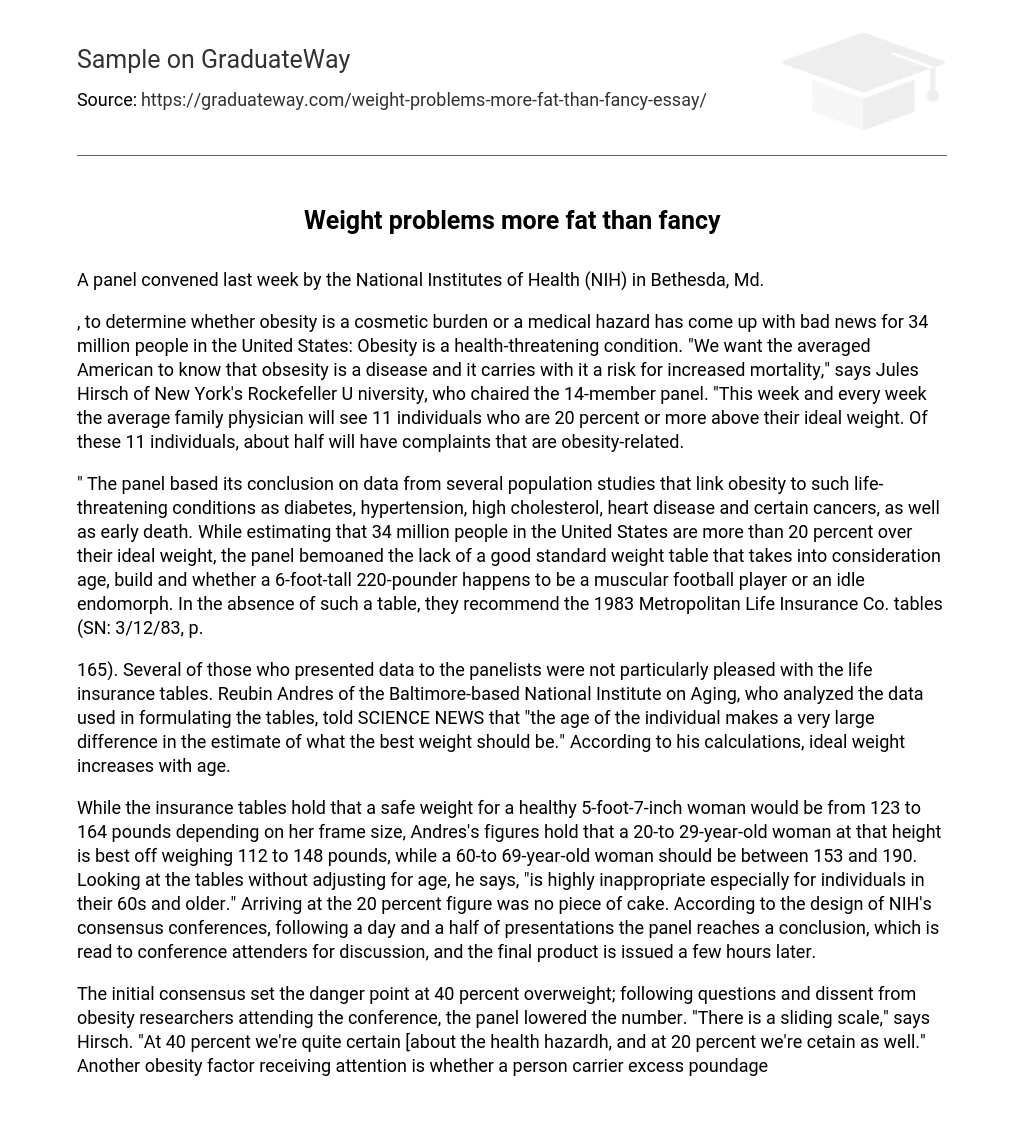A panel convened last week by the National Institutes of Health (NIH) in Bethesda, Md.
, to determine whether obesity is a cosmetic burden or a medical hazard has come up with bad news for 34 million people in the United States: Obesity is a health-threatening condition. “We want the averaged American to know that obsesity is a disease and it carries with it a risk for increased mortality,” says Jules Hirsch of New York’s Rockefeller U niversity, who chaired the 14-member panel. “This week and every week the average family physician will see 11 individuals who are 20 percent or more above their ideal weight. Of these 11 individuals, about half will have complaints that are obesity-related.
” The panel based its conclusion on data from several population studies that link obesity to such life-threatening conditions as diabetes, hypertension, high cholesterol, heart disease and certain cancers, as well as early death. While estimating that 34 million people in the United States are more than 20 percent over their ideal weight, the panel bemoaned the lack of a good standard weight table that takes into consideration age, build and whether a 6-foot-tall 220-pounder happens to be a muscular football player or an idle endomorph. In the absence of such a table, they recommend the 1983 Metropolitan Life Insurance Co. tables (SN: 3/12/83, p.
165). Several of those who presented data to the panelists were not particularly pleased with the life insurance tables. Reubin Andres of the Baltimore-based National Institute on Aging, who analyzed the data used in formulating the tables, told SCIENCE NEWS that “the age of the individual makes a very large difference in the estimate of what the best weight should be.” According to his calculations, ideal weight increases with age.
While the insurance tables hold that a safe weight for a healthy 5-foot-7-inch woman would be from 123 to 164 pounds depending on her frame size, Andres’s figures hold that a 20-to 29-year-old woman at that height is best off weighing 112 to 148 pounds, while a 60-to 69-year-old woman should be between 153 and 190. Looking at the tables without adjusting for age, he says, “is highly inappropriate especially for individuals in their 60s and older.” Arriving at the 20 percent figure was no piece of cake. According to the design of NIH’s consensus conferences, following a day and a half of presentations the panel reaches a conclusion, which is read to conference attenders for discussion, and the final product is issued a few hours later.
The initial consensus set the danger point at 40 percent overweight; following questions and dissent from obesity researchers attending the conference, the panel lowered the number. “There is a sliding scale,” says Hirsch. “At 40 percent we’re quite certain [about the health hazardh, and at 20 percent we’re cetain as well.” Another obesity factor receiving attention is whether a person carrier excess poundage in the upper body or in the hips and below.
Upper-body fat distribution has been linked to an increased risk of diabetes (SN: 1/23/82, p. 52) and the conference included a presentation from a Swedish researcher relating that same pattern of fat distribution to heart disease (SN: 1/26/85, p. 57). “Regional deposits of adipose tissue may be a very important factor,” says Hirsch.
“It turns out in men and women, fat in upper distribution seems to carry a greater hazard for the adverse effects of obesity.” This may be because upper-body fat cells are more active metabolically than fat cells in the thighs and buttocks. Several panel members compared the consensus statement to the Surgeon General’s report in the 1960s declaring smoking to be a health hazard. But whether future Twinkies will carry a warning remains to be seen.
Meanwhile, whast are the 20 percent and overs to do? The topic of how best to lose and hold off weight needs a consensus conference of its own, says Hirsch.





